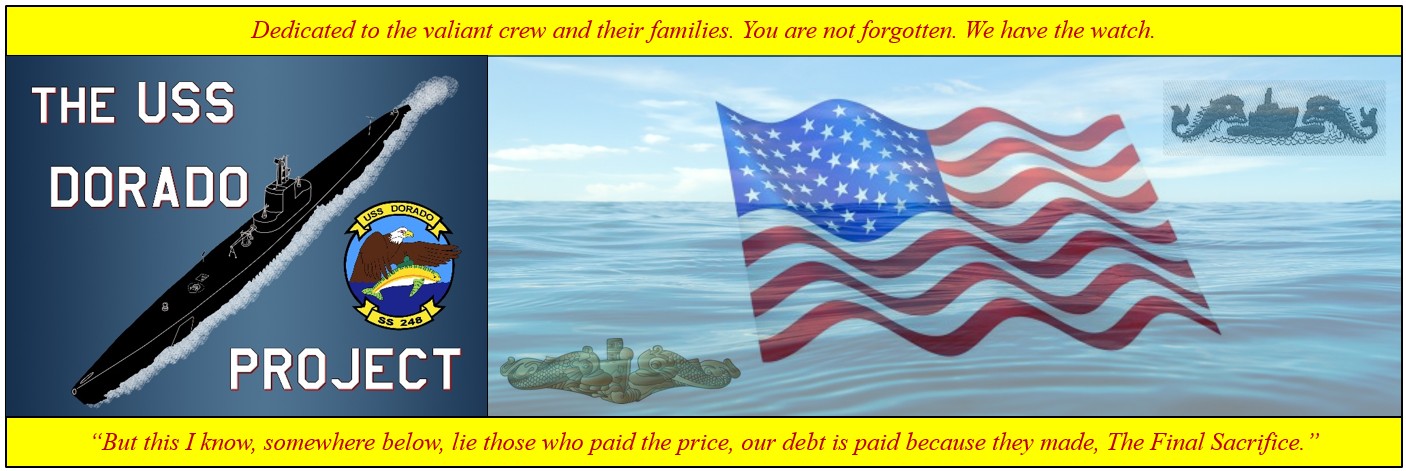Dorado Loss Scenario: Difference between revisions
Pbcjohnston (talk | contribs) Added content to page |
Pbcjohnston (talk | contribs) Updated SSZ graphic |
||
| Line 51: | Line 51: | ||
<div style="text-align: justify;"><span style="color:#000000"> | <div style="text-align: justify;"><span style="color:#000000"> | ||
<br> | <br> | ||
[[File:Dorado submarine sanctuary zone.jpg|left|thumb|400px|<small>Graphic ©Thaddeus Weaver, 2025</small>]] | [[File:Dorado submarine sanctuary zone 2.jpg|left|thumb|400px|<small>Graphic ©Thaddeus Weaver, 2025</small>]] | ||
<div style="text-align: justify;"><span style="color:#00008B">The final element of Dorado's voyage south to Panama was the imposition of a Submarine Sanctuary Zone around the submarine. As the graphic shows, this was a moving zone centered on the submarine's "point of intended movement" or PIM. The PIM at any given time was dictated by the the position that Dorado should be at given her SOA. Dorado's track, her SOA, and the dimensions of this moving sanctuary zone were transmitted to all Allied commands in the Atlantic and Caribbean. The purpose of which was to prevent a blue-on-blue, or friendly fire incident from happening. Under no circumstances were any attacks to be made on suspected submarines within this zone, unless the ID of the submarine could be absolutely confirmed. | <div style="text-align: justify;"><span style="color:#00008B">The final element of Dorado's voyage south to Panama was the imposition of a Submarine Sanctuary Zone around the submarine. As the graphic shows, this was a moving zone centered on the submarine's "point of intended movement" or PIM. The PIM at any given time was dictated by the the position that Dorado should be at given her SOA. Dorado's track, her SOA, and the dimensions of this moving sanctuary zone were transmitted to all Allied commands in the Atlantic and Caribbean. The purpose of which was to prevent a blue-on-blue, or friendly fire incident from happening. Under no circumstances were any attacks to be made on suspected submarines within this zone, unless the ID of the submarine could be absolutely confirmed. | ||
Revision as of 18:02, 27 June 2025

| Main Page | Latest News & Updates | The Submarine | The Crew | Photographs | The Loss Scenario | The Aircraft | Case for the Purple Heart | The Myths | Research Documents |
The Departure

She passed under the U.S. Route 1 bridge, with the venerable structure lifted open to allow the boat to pass underneath. She passed the main Electric Boat facility on her port beam, and a little further downstream she passed the Victory Yard where she was built. Men and women toiling in the cool October air on Dorado's sister subs paused for a moment, proudly acknowledging their handiwork as the submarine passed. They wished her luck as she headed off to war.
Fishing vessels hailed her as she passed the mouth of the Thames and Schneider rang up an ahead standard bell with turns for 14 knots. The bridge watch team kept a wary eye on the Fisher's Island and Montauk ferries as they passed, with a little maneuvering left and right intended to keep the ferries at a safe distance. Clearing Fisher's Island she made a slight turn to the southeast, putting her on course to pass down the middle between Montauk Point on her starboard side and Block Island on her port. Down below in the control room the Quartermasters and the Navigator were busy piloting the submarine, shooting bearings with the periscope to land-based navigation aids, using those bearings to triangulate their position on the chart. With Montauk Point on their starboard quarter, they took their "point of departure", i.e. the last confirmed land-based navigational fix, and headed out into the blue Atlantic.
The Voyage

The final waypoint was Point George, 15 nautical miles (NM) north of the Cristobal Breakwater, a structure that defined the harbor for Cristobal and Colon. At George the Dorado was to rendezvous with a U.S. destroyer, who would escort Dorado on the surface the last few miles to the submarine base. This rendezvous was supposed to happen on the morning of October 14. This date/time is very important for several reasons:
- Being escorted into the harbor by the destroyer would prevent Dorado from being mistaken for a German submarine (known to be operating in the Caribbean) and being fired upon by friendly forces.
- Traffic through the canal was was very high, and specific times were assigned to ships for passage so that the possibility of traffic jams was avoided. If Dorado missed her transit time, it would delay her voyage all the way to Pearl Harbor and the war zone.
- The date/time of her arrival at Point George also dictated the speed of her transit, known properly as her "speed of advance" (SOA). To make Point George on time her SOA was 14 knots. This was also a fuel efficient speed and was well within her maximum surface speed of 21 knots. However, it also dictated that Dorado make the transit mostly on the surface, as her maximum submerged speed was only eight knots. LCDR Schneider had the discretion to submerge as he saw fit for drills and training, but he had to maintain the average speed of 14 knots in order to make George on time.


The zone was big enough to allow the zig-zag course to be conducted, and for periodic dives for training and drills. However, it was incumbent upon the crew of Dorado to ensure they stayed within the zone at all times. Allied surface and aerial forces were understandably trigger-happy due to the threat of German submarines, and this zone was intended to eliminate the "friendly" threat to U.S. submarines transiting to Panama.
October 12, 1943
Page created by:
Thaddeus Weaver & David Johnston
©2025 - Thaddeus Weaver & PigBoats.COM
West Warwick, RI, Norfolk, VA
ussdoradoproject@gmail.com